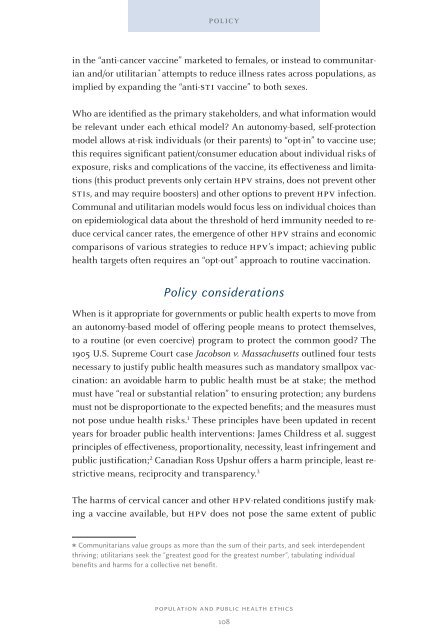PoPulationand Public HealtH etHics
PoPulationand Public HealtH etHics
PoPulationand Public HealtH etHics
You also want an ePaper? Increase the reach of your titles
YUMPU automatically turns print PDFs into web optimized ePapers that Google loves.
policy<br />
in the “anti-cancer vaccine” marketed to females, or instead to communitarian<br />
and/or utilitarian * attempts to reduce illness rates across populations, as<br />
implied by expanding the “anti-stI vaccine” to both sexes.<br />
Who are identified as the primary stakeholders, and what information would<br />
be relevant under each ethical model? An autonomy-based, self-protection<br />
model allows at-risk individuals (or their parents) to “opt-in” to vaccine use;<br />
this requires significant patient/consumer education about individual risks of<br />
exposure, risks and complications of the vaccine, its effectiveness and limitations<br />
(this product prevents only certain HPV strains, does not prevent other<br />
stIs, and may require boosters) and other options to prevent HPV infection.<br />
Communal and utilitarian models would focus less on individual choices than<br />
on epidemiological data about the threshold of herd immunity needed to reduce<br />
cervical cancer rates, the emergence of other HPV strains and economic<br />
comparisons of various strategies to reduce HPV’s impact; achieving public<br />
health targets often requires an “opt-out” approach to routine vaccination.<br />
Policy considerations<br />
When is it appropriate for governments or public health experts to move from<br />
an autonomy-based model of offering people means to protect themselves,<br />
to a routine (or even coercive) program to protect the common good? The<br />
1905 U.S. Supreme Court case Jacobson v. Massachusetts outlined four tests<br />
necessary to justify public health measures such as mandatory smallpox vaccination:<br />
an avoidable harm to public health must be at stake; the method<br />
must have “real or substantial relation” to ensuring protection; any burdens<br />
must not be disproportionate to the expected benefits; and the measures must<br />
not pose undue health risks. 1 These principles have been updated in recent<br />
years for broader public health interventions: James Childress et al. suggest<br />
principles of effectiveness, proportionality, necessity, least infringement and<br />
public justification; 2 Canadian Ross Upshur offers a harm principle, least restrictive<br />
means, reciprocity and transparency. 3<br />
The harms of cervical cancer and other HPV-related conditions justify making<br />
a vaccine available, but HPV does not pose the same extent of public<br />
* Communitarians value groups as more than the sum of their parts, and seek interdependent<br />
thriving; utilitarians seek the “greatest good for the greatest number”, tabulating individual<br />
benefits and harms for a collective net benefit.<br />
PoPulation anD <strong>Public</strong> <strong>HealtH</strong> <strong>etHics</strong><br />
108
















